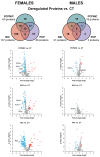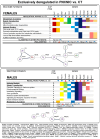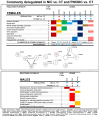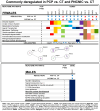Nucleus Accumbens Proteome Disbalance in an Adolescent Mouse Model of Schizophrenia and Nicotine Misuse Comorbidity
- PMID: 40299488
- PMCID: PMC12025060
- DOI: 10.3390/biomedicines13040901
Nucleus Accumbens Proteome Disbalance in an Adolescent Mouse Model of Schizophrenia and Nicotine Misuse Comorbidity
Abstract
Background/Objectives: Schizophrenia and nicotine misuse are a comorbid condition that frequently develops during adolescence. Considering the role of the nucleus accumbens (NAcc) as a common neurobiological substrate for these psychiatric disorders, label-free proteomics was employed to identify NAcc deregulated proteins in male and female mouse models of schizophrenia with a history of adolescent nicotine exposure. Methods: Phencyclidine was used to model schizophrenia, and minipump infusions were used to model nicotine misuse. Results: Enrichment Reactome pathway and protein-protein interaction analyses showed that the cytoskeleton and associated synaptic plasticity mechanisms, energy metabolism, and nervous system development were affected in both sexes. In particular, Ncam1 (Neural cell adhesion molecule 1) could be of interest as a candidate marker of synaptic plasticity disbalance. Its deregulation in the NAcc of both sexes suggests that it lies at the core of the comorbidity pathophysiology. When considering sex-selective effects, Cs (Citrate synthase) and Mapk3 (Mitogen-activated protein kinase 3) were identified as exclusively deregulated in female and male mice, respectively. Since both proteins were previously shown to be exclusively deregulated in the medial prefrontal cortex of co-modeled mice, a common mesocortical and mesolimbic system effect can be inferred, supporting the role of aberrant energy metabolism and synaptic plasticity in the comorbidity model. Conclusions: The current data provide insights into the NAcc proteome disbalance in an adolescent preclinical model of combined schizophrenia and nicotine misuse, pointing to relevant pathways and early markers of the comorbidity.
Keywords: E-cigarette; co-exposure; mass spectrometry; mental disorder; mesolimbic system; nicotine addiction; prodrome; proteome.
Conflict of interest statement
The authors declare no conflicts of interest. The funders had no role in the design of the study; in the collection, analyses, or interpretation of data; in the writing of the manuscript; or in the decision to publish the results.
Figures





Similar articles
-
Nicotine Exposure in a Phencyclidine-Induced Mice Model of Schizophrenia: Sex-Selective Medial Prefrontal Cortex Protein Markers of the Combined Insults in Adolescent Mice.Int J Mol Sci. 2023 Sep 27;24(19):14634. doi: 10.3390/ijms241914634. Int J Mol Sci. 2023. PMID: 37834084 Free PMC article.
-
Effects of Environmental Enrichment on Nicotine Sensitization in Rats Neonatally Treated with Quinpirole: Analyses of Glial Cell Line-Derived Neurotrophic Factor and Implications towards Schizophrenia.Dev Neurosci. 2018;40(1):64-72. doi: 10.1159/000486391. Epub 2018 Feb 14. Dev Neurosci. 2018. PMID: 29444518
-
Does nicotine exposure during adolescence modify the course of schizophrenia-like symptoms? Behavioral analysis in a phencyclidine-induced mice model.PLoS One. 2021 Sep 29;16(9):e0257986. doi: 10.1371/journal.pone.0257986. eCollection 2021. PLoS One. 2021. PMID: 34587208 Free PMC article.
-
The anatomy of co-morbid neuropsychiatric disorders based on cortico-limbic synaptic interactions.Neurotox Res. 2006 Oct;10(2):65-85. doi: 10.1007/BF03033236. Neurotox Res. 2006. PMID: 17062369 Review.
-
nAChR dysfunction as a common substrate for schizophrenia and comorbid nicotine addiction: Current trends and perspectives.Schizophr Res. 2016 Mar;171(1-3):1-15. doi: 10.1016/j.schres.2016.01.020. Epub 2016 Jan 21. Schizophr Res. 2016. PMID: 26803692 Free PMC article. Review.
References
Grants and funding
- 001/Coordenação de Aperfeicoamento de Pessoal de Nível Superior
- 304368/2020-2/National Council for Scientific and Technological Development
- 308194/2023-3/National Council for Scientific and Technological Development
- SEI-260003/001135/2020/Fundação Carlos Chagas Filho de Amparo à Pesquisa do Estado do Rio de Janeiro
- E-26/200.957/2021/Fundação Carlos Chagas Filho de Amparo à Pesquisa do Estado do Rio de Janeiro
LinkOut - more resources
Full Text Sources
Research Materials
Miscellaneous

